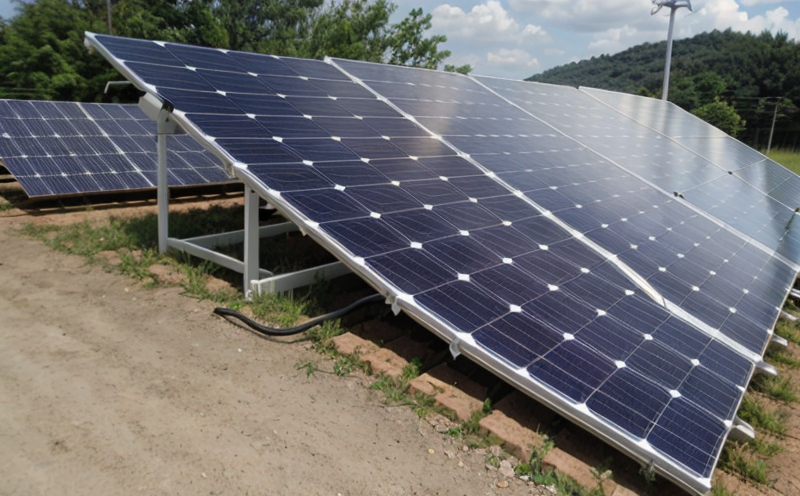IEC 61730-2 Flammability Testing of PV Components
The International Electrotechnical Commission (IEC) Standard IEC 61730-2 provides a comprehensive framework for the flammability testing of photovoltaic (PV) components. This standard is crucial in ensuring that PV modules, solar cells, and related systems are safe and meet stringent safety requirements. Compliance with this standard is mandatory for manufacturers to ensure their products can be sold internationally.
The IEC 61730-2 testing process involves subjecting the PV component under test (PVCT) to various environmental conditions that simulate real-world scenarios. These tests are designed to evaluate the potential of a module or cell to ignite and spread fire when subjected to specific stressors such as mechanical impact, exposure to flame, and thermal cycling. The primary goal is to ensure that PV components do not pose an ignition risk under normal operating conditions.
The testing procedure for IEC 61730-2 involves several key steps:
- Specimen preparation: Ensuring the PVCT is representative of the component type being tested.
- Environmental conditioning: The specimen is conditioned to simulate real-world environmental factors, including temperature and humidity.
- Flame application: A controlled flame is applied to the specimen to simulate potential ignition sources.
- Data acquisition: Detailed data on combustion behavior are collected to determine compliance with safety criteria.
The testing process requires precise instrumentation such as calorimeters, thermocouples, and video analysis systems. The specimens must also be prepared according to specific guidelines outlined in the standard. Once the test is completed, detailed reports are generated that provide comprehensive data on the specimen's performance under the specified conditions.
Compliance with IEC 61730-2 ensures that PV components can withstand environmental stresses without igniting or propagating a fire. This standard plays a critical role in safeguarding public and property safety, particularly in areas where PV systems are installed.
The importance of this testing cannot be overstated, especially given the increasing reliance on renewable energy sources globally. Compliance with IEC 61730-2 ensures that PV components can be trusted to perform safely under various conditions. This standard is widely accepted and recognized by regulatory bodies around the world, making it a cornerstone in the design and manufacturing of safe PV products.
Manufacturers who comply with this standard not only ensure their products meet safety standards but also enhance their reputation for quality and reliability. The testing process is rigorous and designed to identify potential hazards early in the development cycle, allowing manufacturers to address any issues before product release.
Why It Matters
The flammability testing outlined in IEC 61730-2 is critical for ensuring that PV components do not pose a fire hazard. The potential risks associated with non-compliant PV modules include:
- Potential damage to the module itself.
- Increased risk of fire within solar installations, leading to property loss and personal injury.
- Negative impact on brand reputation if safety issues are discovered post-market.
The standard is designed to address these risks by providing a robust framework for testing that simulates real-world conditions. By ensuring that PV components meet the specified criteria, manufacturers can have confidence in their products' performance and reliability.
Compliance with IEC 61730-2 also helps to build trust between manufacturers, distributors, and end-users. When products are tested and certified according to this standard, they carry a level of assurance that they meet international safety requirements. This is particularly important for exporters who need to comply with different national standards in various markets.
The testing process not only ensures the safety of PV components but also contributes to the broader goal of promoting renewable energy technology. By reducing fire risks associated with PV installations, compliance helps to foster greater adoption of solar power systems worldwide.
International Acceptance and Recognition
- Australia: The Australian Renewable Energy Agency (ARENA) recognizes IEC 61730-2 for the safety testing of PV modules. Compliance with this standard is a requirement for export to Australia.
- Canada: The Canadian Standards Association (CSA) incorporates IEC 61730-2 into its own standards, ensuring compatibility and acceptance in the Canadian market.
- European Union: PV manufacturers must comply with IEC 61730-2 to obtain CE marking for their products. This is a prerequisite for marketing PV components within EU member states.
- New Zealand: The New Zealand Standards Institute (NZSI) has adopted IEC 61730-2, ensuring that PV modules meet the same safety standards as those in Australia and other countries.
- Singapore: Singapore's energy regulatory body, the Energy Market Authority (EMA), recognizes IEC 61730-2 for compliance with local regulations.
The widespread acceptance of IEC 61730-2 reflects its importance in ensuring that PV components meet international safety standards. This standard is a key component of global efforts to promote the safe and reliable use of renewable energy technology.
Use Cases and Application Examples
The IEC 61730-2 flammability testing is widely applicable across various sectors, including:
- Solar Power Plants: Ensuring that PV modules used in large-scale solar power plants are safe from fire risks.
- Rooftop Installations: Protecting residential and commercial properties with rooftop solar panels by ensuring they meet safety standards.
- Off-Grid Systems: Guaranteeing the safety of standalone PV systems used in remote locations where fire hazards are a concern.
In practice, this testing is often carried out during the R&D phase to identify potential risks early on. Manufacturers can then implement design changes or material substitutions to address any issues that arise during testing. This proactive approach helps ensure that products meet safety standards before they reach the market.
For example, a manufacturer of solar panels may conduct IEC 61730-2 tests to evaluate the flammability risk associated with a new polymer used in the encapsulant layer. By identifying potential issues early on, the company can make necessary adjustments to the design, thus ensuring that the final product is safe for use.
Similarly, during procurement processes, suppliers of PV components may be required to demonstrate compliance with IEC 61730-2 as part of their quality assurance protocols. This ensures that all materials and subcomponents used in the production process meet international safety standards.





